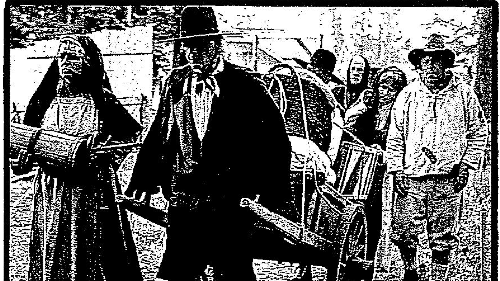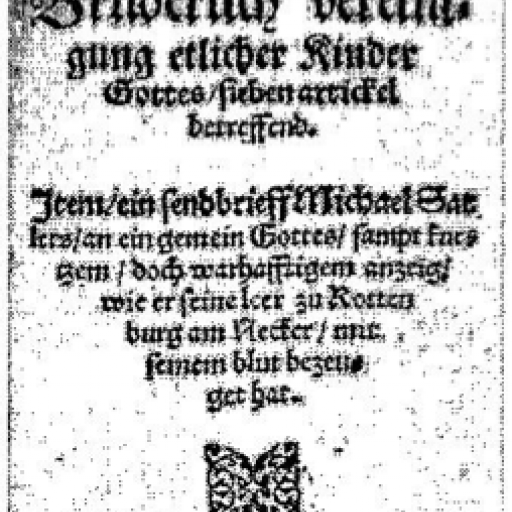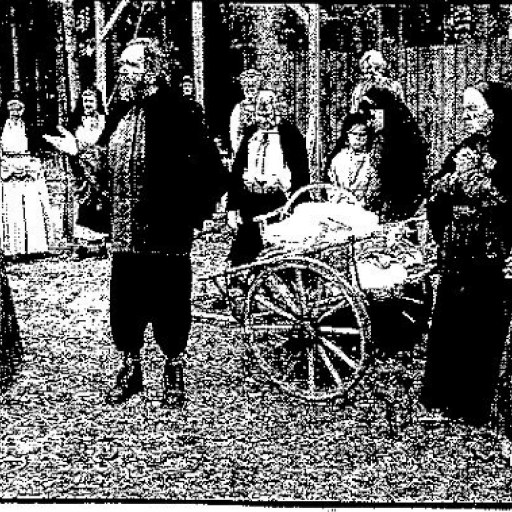Introduction
The theme of "The Hunt for the Anabaptists" as a course topic in the BESJ camp staff course 2006/07 fits - unconsciously - into a whole series of official and private projects on the "Anabaptist Year 2007 - The truth shall be told". On the occasion of this Anabaptist Year, theatre will be performed, books written, trips organised and much more.
The camp staff course primarily trains BESJ youth leaders to become Youth+Sport leaders in the sport of camp sports/trekking. Secondarily, a theme is introduced to the leaders so that they in turn can organise and run appropriate camps. This dossier has been compiled to introduce the participants and leaders of these courses (and later, if necessary, also interested parties) to the subject. It does not claim to be complete or without errors. Rather, it is intended to provide an overview so that camp organizers have background knowledge.
This dossier mainly describes the events concerning the Bernese Anabaptists. Where necessary, information from the immediate and wider environment has been woven in. For more in-depth introductions, a more detailed version existed in BESJ.
We would like to take this opportunity to thank Dr. Hanspeter Jecker, Bienenberg Bible School, for the valuable information and historical overview, as well as for proofreading the raw version.
We wish you, the reader-whether a participant or leader in a camp staff course or an interested party-much profit in exploring Switzerland's Anabaptist historical heritage and your camp participants much enjoyment in camps on this exciting topic.
Lori Keller and Sara Kündig
History
We begin with the Reformation
The Reformation is a 16th-century movement that saw the breakaway from the Roman Catholic Church and the emergence of the Reformed, Lutheran, and Anglican churches, as well as some free churches. The common foundations are found in the renunciation of Catholic doctrines and the return to the Bible and its teachings. Separation from the Roman Catholic Church was not initially the intention of the Reformers. The idea was originally that Christian doctrine would be restored to the Catholic Church. The Reformation did not originate in one place by one person - there were different centres and different reformers who came from different backgrounds and worked in different political circumstances. The trigger to the Reformation cannot be defined in a single point, rather it was various things that accumulated and came to explode at some point in the climax.
There were, for example, various reform resolutions that were pending, worked out, and then not adopted as they should have been. Existing resolutions were weakened by the Pope. Various taxes, fees and levies flowed into the papal coffers. These were considered too high by many princes. In addition, the sale of indulgences - forgiveness of sins could be purchased - came under increasing criticism. A decisive turning point came with the translation of the Bible into German by Martin Luther. The growing book printing trade made it possible to publish the Bible and above all various "heretical writings" of the Reformers in large editions. For the first time, people were encouraged to read the Bible on their own, which was not allowed in the Catholic Church, so that many unanswered questions arose as a result. The writings of the Reformers were also read with interest. People began to question the Catholic Church with its teachings, and so many things were discovered that could not be supported by the Bible.
Criticism of existing tradition
There are two approaches in criticizing the tradition of the early church that have been supported from various quarters:
- Luther subjected the tradition of the church to rigorous scrutiny. The yardstick was the text of the Bible. Traditions which, in his opinion, were contrary to Scripture were to be abolished. He advocated, however, that traditions that were not directly based on the Bible but were helpful to the lives of believers be retained.
- Zwingli and Calvin rejected all traditions that were not grounded in the Bible. From there, the Reformed have sober houses of worship, decorated at most with Bible verses. Zwingli, in part, even rejected instrumental music in church. The Lord's Supper, he said, was a memorial service.
Political developments
As noted above, it was not only the political or social grievances of the church that led to the triggering of the Reformation. rather, these aspects provided fertile ground for the reformers' new theological thoughts. The theological struggle for the correct interpretation of the Bible was soon joined by political aspects. The new ideas gave the princes of the empire a theological justification for reducing the tax burden imposed by Rome. The emergence of the Protestant regional churches also strengthened the autonomy of the principalities. the first half of the sixteenth century saw various wars between Catholics and Protestants within Germany and Switzerland, which ended in Germany in 1555 with the Augsburg religious peace and in Switzerland in 1531 with the second land peace of Kappel. In both, it boiled down to "cuius regio - eius religio" (whose country's faith). For Germany, this meant that the respective prince determined the denomination of his country, while in Switzerland it was decided by the respective republican government in the canton.
The radical approaches
For reformers like Thomas Müntzer, Andreas Bodenstein von Karlstadt, Menno Simon or Jakob Hutter, the time was under apocalyptic omens. Some of them interpreted the events in a spiritualistic way and saw their task in paving the way for the Kingdom of God, which in their eyes was really coming, as an eschatological reign of justice. However, it remains to be said that the "radicals" took very different approaches.
They enthusiastically sought the creation of end-time structures. the churches were to consist of those baptized in true faith (rebaptism/adult baptism). They worked right into the political structures, sometimes reversing social and political conditions in a revolutionary way - in the form of the famous Peasants' Wars.
This met with fierce resistance not only on the part of the social upper class and the Catholic Church. The Protestants, with Luther at their head, also called for a violent end to the unrest. The princely troops put an end to the uprisings by force of arms - the Anabaptists only found religious freedom as emigrants in America. Around the middle of the 16th century a second generation of reformers came to the fore. In Geneva this was John Calvin and in Zurich Heinrich Bullinger, Zwingli's successor. Their contribution was to consolidate the Reformation theologically - Calvin with his "Institution", Bullinger with the "Second Helvetic Confession". Both exerted a Europe-wide influence on Protestantism.
The reaction of the Catholic Church
The Catholic Church first tried to persuade, then shifted to political and ecclesiastical pressure. Luther had to flee and survived only thanks to princely protection. Zwingli, on the other hand, succeeded in convincing the Zurich council of the correctness of his doctrine. The new ideas of the Reformation spread like wildfire - the population flocked to the new faith, imperial cities and princes switched to the side of the Reformation. The then Emperor Charles V remained Catholic, but could not concentrate on suppressing the Reformation, as foreign policy (Turkey and France) kept him very busy. Subsequently, the foundation of the Jesuit order initiated the Reformation within the Catholic Church. The Reformation was one of the great turning points in the history of the Occident. For the history of Christianity, the Reformation meant that the existing omnipotence of the Catholic Church could be subdued.
Anabaptists around Zurich, around Schaffhausen
Anabaptists around Zurich
Ulrich Zwingli became a pastor in Glarus in 1506 and took an active part in the campaigns of the Glarusers for the Pope in Lombardy in 1512-1515. While at first he was heavily involved with humanistic writings, he later became intensively occupied with the newly published Greek New Testament of Erasmus of Rotterdam. In doing so, he came to the conclusion that the teachings of the Church did not agree with the New Testament in some things. In 1516 he began to preach against pilgrimages, indulgences, and other church abuses. He urged the bishops to improve the church according to the guidance of the divine Word. In 1519 Zwingli came to Zurich to interpret the Gospels on an ongoing basis. He brought the Zurich council to the point where they required all preachers to preach according to the gospel. At the beginning of his time in Zurich the Anabaptist leaders were his comrades, but after various disputations he became a bitter opponent of them. For the Zurich Anabaptists, the Reformation under Zwingli proceeded far too slowly and with too little consistency. Many had waited a long time for the Reformation. And now that it was legally accomplished, they wanted to quickly and radically reorganize the church in an original Christian image. But Zwingli hesitated. The Reformation came about by council decision. So Zwingli could not simply throw away the Mass and the whole Roman religion. It had to have its time and mature, even if it would take years to complete the Reformation. Additional obstacles were that not everyone in Zurich was behind the Reformation, but there were also many who wanted to stay with the Roman traditions. The other side did not want to follow the biblical model at all, but simply wanted to break radically with everything that had a Roman influence. Zwingli was thus confronted with different views and had to proceed wisely to get the Reformation on good ground. Zwingli and the Anabaptists were in agreement on principles, so there need not have been a break. But the long wait for change caused a growing intolerance among the Anabaptists. As time went on, this fire of intolerance was stoked more and more until the bomb burst.
Anabaptists around Schaffhausen
The most famous document of Schaffhausen Anabaptism is the Schleitheim Confession, drafted by Michael Sattler on the occasion of the Anabaptist Synod of 24 Feb 1527. It is not a summary of the most important Anabaptist beliefs, but aims to clarify certain points of contention among the Anabaptists and to shed light on them from the Bible. The seven topics covered are: Baptism, Church Discipline, the Lord's Supper, Separation from the World, Shepherding, Authority, and Oath. The essential articles of the Schleitheim Confession are noted below. They are greatly abridged, but nevertheless give some insight into the thoughts of the Anabaptists.
- On Baptism
Baptism is to be given to all those who have been instructed about repentance and amendment of life, and truly believe that their sins are taken away by Christ. This excludes all infant baptism, the pope's highest and first abomination.
- On Shepherds in the Church
The shepherd of the church of God is to be altogether, according to Paul's order, one who has a good reputation from those who are outside the faith. His office shall be to read, exhort, teach, exhort, rebuke, exorcise, preach, begin to break bread, and have heed in all things of the body of Christ.
- On Authority
Authority is an order of God outside of the perfection of Christ. It punishes and kills the wicked and protects and shields the good.
First: Christians are not to use the sword against others.
Second: Christians are not to pass judgment on others.
Third: Christians are not to belong to the authorities.
Finally: Our head is Christ and we as his members are to act according to Christ's mind.
- On the Oath
The oath is an affirmation among those who quarrel or make promises, and it is commanded in the law that it should be taken truly and not falsely in the name of God alone. Christ, who teaches the fulfillment of the law, who forbids His own all swearing, both right and wrong, both by heaven and earth.
Anabaptists around Bern
"Are you with the rebaptizers now, too? Since when have we had such a pestilence in office again? Knowest thou that no Anabaptists are tolerated here? I believe Brandis is clean at present, except for a few stubborn women there is no one left with that pack, only a few still hiding behind Trachselwald and Langnau!"
These words from a Bernese bailiff to a young man who had recently converted to the Anabaptists reflect the general view of the Anabaptists in Switzerland.
It is not easy to get an insight into the Anabaptist history around Bern. One does not have an optimal information base for this part of Switzerland. Although one can find data here and there, it is very incomplete and mostly very brief. Almost all information comes from Anabaptists who made confessions under cruel torture. Thus the statements of the Anabaptists are very inaccurate and one sometimes comes across names that appear out of nowhere and disappear again. There is also the question of which people can be called Anabaptists. Where does one classify men like Thomas Müntzer - as Anabaptists or Lutherans? Many, therefore, must be called Anabaptist friends, but not actual Anabaptists.
The Bernese Anabaptist circle was a down-to-earth community whose adherents cannot be described as fickle ephemera. They were prepared to take on all sorts of hardships. They did not shy away from interrogation and torture. And they were not afraid to walk many miles to get to their secret meetings. They strongly advocated the Bible knowledge they recognized.
Arrested - interrogated - drowned
Eight Anabaptists also appeared at the Bern Disputation of 1528, where the decision to introduce the Reformation was made. They were not admitted, but arrested. Only after the conclusion a discussion took place, in which Zwingli himself tried to convict the Anabaptists of their error. Without success. They were forbidden city and country and threatened with death if they returned. Three of them, however, did return. They were arrested and interrogated. In mid-July 1529 they were drowned in the Aare. On March 13, 1535, it was decided by the authorities that from "now on the Mansbilder would be judged with the sword, but Wybsbilder with the water on grace from life to death". The above-mentioned death sentence of the three Anabaptists is not the only one. Hans Haslibacher of Haslibach near Sumiswald is also one of the many documented Anabaptists executed in Bern between 1528 and 1571.
Hunting people
The mandate of 1583 states, "To exterminate this seditious sect is of no avail, it multiplies from day to day. The Anabaptist leaders, preachers, teachers and ringleaders are to be judged with the sword without mercy. The magistrates shall also hire and pay men to pursue the chiefs and ringleaders day and night. Farms of Anabaptists, where there are no children, shall possibly be sold."
Tough times were dawning for the Bernese Anabaptists. From the chief offices and from Bern, Weibel and other (more or less) commissioners hunted "human game." Real hunts were organized. These were quite lucrative, because in the "Amtsbücher" are noted again and again amounts, which were paid out, if the hunt was successful. Once 100 guldens (1 guldens = 2 pounds) were put out on an Anabaptist teacher, in order to get hold of him. In a chronicle the following is noted. "1644 - Great Anabaptist Jegi. The government searches for Ueli Zaugg, Ueli Neuhaus and Christen Stauffer on the Äbnit in Eggiwil. Many Anabaptists in prison, 48 of them expelled."
Torture
Torture was used to try to force confessions from both men and women, to learn the names of their brothers and sisters in the faith, their "doctrine" or the places where they gathered, or to dissuade them from their "false doctrine." In one document it says among others: "...he was pulled up empty by the rope..." The second time, the same person was raised with a stone attached. Another man is reported to have been pulled up empty the first time, then with a small stone, and the third time with a stone weighing 75 pounds. The women, for example, were put on the thumbscrew. In a mandate of 1670 it says: "... such disobedient and unruly heads with ruthen publicly whittle and lead over it on the border." If they should enter the country again, they would be dealt with "with the same tractament" and about it they would still "draw with the Brönnysen".
Fine
In an open letter, which was read from the pulpits of the offices of Signau, Trachselwald and Brandis, it says, for example, that the Anabaptists would be fined 10 pounds and "so sy nicht abstan, an Lyb und Gut schaffen, auch an denen die sy husend ihre heusser und schür uff den grund hynwägschlyssen werde". A son had to pay 10 pounds fine because he had "ghuset und ghofel" his Anabaptist father without permission. The following is also recorded: "1599. from Hanns Gerber, the old in Goldt der Kilchöri Langnow, von wägen syner ungehorsamen widerthäuferischen ehefrouwen gutt yngenommen 1800 Pfund."
Protection of Anabaptists by citizens
The secular authorities gave the ecclesiastical authorities the official order in 1585: "Wöllend alle Prädikangen, die in das hiesig Capitel gehören, versammeln und miteindern sich ettlicher Mitteln die täuferischen lehren und Versammlungen abschaffen ((beraten) und dann ihr meinung min Herren berichten." The spiritual lords reported among other things: "... The seducers and false teachers with all diligence and earnestness from E. Gn. Ländergetrieben werden..." All subjects were to be seriously forbidden to "behuse and help" any Anabaptist. No trade, neither buying nor selling, is allowed with the Anabaptists. They are to be denounced, so that they may be instructed by suitable predicates. If they cannot be instructed, they are to be kept with "mush and bread until their obstinacy is broken, or they are sent out of the country according to E. Gn. Erkanntnus be sent out of the country."
Country Expulsion
In response to this opinion, the government published a new mandate in which it proclaimed, among other things: *Das die (die Täufer) aber kein wahrnung noch unterwysung annehmen, halsstarryg und ungehorsam belyben, auch nit usschweren wöltendm söllendt gfönglich uff die Grenzen der Landsmarch führen, uss unser Lande gewiesen werden, that we are determined, if they come again into our country and are seized, but do not stop, but as before in their error, break their necks, destroy them as disobedient, renegades, myneige lüt an lyb und läben." Often Anabaptists were driven across the border completely destitute. Many could not stand it and returned. Hundreds had to leave the country over time, men women and children. Families were torn apart, one part had to leave, the other stayed behind. In 1672 there was a large, violent expulsion. About 700 people moved to the Palatinate. Others were loaded onto boats at the Schifflände in Bern, from where they were taken out of the country.
Off to the galleys
The climax of the persecution in the 17th century was the council's decision to "ship" the Anabaptists off to the galleys. After the Anabaptist riots in Eggiwil in 1671, a circular letter was addressed to all officials and fathers, which stated, among other things: "We are sending a number of those of our disobedient subjects of the so-called Teüffern tied to irons in Italy to the Venetian galleys for rowing work, and are determined to proceed against all those who show themselves disobedient in such a manner in the same way..." These were not empty words. What was written down was also carried out. Twelve Anabaptists were sentenced to two years' service in galleys, and on March 16 six of them were taken, bound together, to a ship at Thun, and from there to a ship via Interlaken. Now the journey continued to Bergamo and Venice. A mandate of 1670 stipulated that the goods of those shipped were to be sold. The government was anxious to expel the Anabaptists penniless if possible and to keep their property in the country. Numerous farms of peasants were subsequently confiscated.
Love of Charity
Not everyone took part in the persecution of the Anabaptists. Time and again there were people who were willing to help those who were persecuted, even if they were in danger of being punished for it. For example, the Anabaptist hunters were unpopular with the people. Wherever they appeared, they caused trouble. The country people often took sides with the Anabaptists who were in trouble. Measures taken by the governments could sometimes be prevented. The Anabaptists also received help from their brothers and sisters in the faith abroad (Palatinate, Netherlands, Alsace). Despite all efforts on the part of the authorities, the Anabaptists did not disappear.
End of the Anabaptist persecutions in Bern
In contrast to the Zurich Anabaptists (until about 1620), Anabaptism was able to continue in the valleys of the Emmental, which were more difficult to access and thus to control. In 1711, a mass exodus of about 350 Anabaptists from Bern and Neuchâtel took place on four ships down the Aare, mostly in the direction of Holland. Quite a few traveled on to America, where they settled as "Amish". The Anabaptists who remained behind experienced another flare-up of Anabaptist persecution around 1718 due to a new Anabaptist mandate. In 1743 the Bernese Anabaptist Chamber was abolished and in 1798 the first Helvetic Constitution guaranteed religious freedom. From 1810, Anabaptists were officially tolerated as long as they did not engage in missionary activities. However, they had to dress in accordance with the "Anabaptist Order" and in some cases they were even baptised by force. It was not until 1820 that births, marriages and congregations were recognized. Thus the persecution of Anabaptists was finally assigned to the chapter of (sad) history.
Amish
Amish, a branch of the Mennonites
The Amish (English Amish) is a religious community which has its roots in the Anabaptist movement of the 16th century. In 1693/94 it came in the circle of the Old Anabaptists (Mennonites) due to disputes in questions of church discipline to a split provoked by Jacob Amann. Jacob Amann, called "Patriarch", who has his roots in Simmental BE, founded the first Amish community in Alsace in Ste-Marie-aux-Mines.
The "brethren" of Alsace were called to strict discipline in the practice of religion. Because of the strictness, Amann and his followers soon came into conflict with the old Anabaptists of Alsace, and later also in Switzerland and the Palatinate. In 1712, by order of Louis XIV, the entire Anabaptist community had to relocate. So they went to the nearer and further surroundings, partly also again to Switzerland (Neuchâtel and Principality of Basel).
At the beginning of the 18th century, religious and economic pressures on the Amish increased and so they emigrated to the States of America in the years 1707-1754. Settlement was concentrated in the state of Pennsylvania in the early years. In a second wave of emigration around 1815, about 3000 Swiss Amish settled in the states of Ohio, Indiana, Illinois and Ontario (Canada). In the years that followed, many Amish imitated the example of the first emigrants, which is why today we find many Amish communities in the northern and eastern United States, as well as in southern Canada.
The Amish are a faith community based on a particular "order". They are commonly known for feeling a very austere lifestyle. Most Amish families make their living in the field of agriculture. A great deal of emphasis is placed on family, community, and seclusion. They strictly reject technical progress in most cases. A special tradition is the textile art "patchwork". To represent the imperfection of the people, a flaw is deliberately worked into each of these individual works.
Religion
Every two weeks a service is held in the yard of a chosen member for the whole congregation. During the service, men and women sit separately. The preacher is forbidden to use notes. The complete sermon is delivered freely. Afterwards, the congregation eats together. The children of the Amish are baptized after the age of 16. Thereby the children or in the meantime young people are supposed to decide consciously for a life as Amish or to go another way willingly. Whoever breaks his baptismal promise is banned from the community (e.g. no one eats at the same table with an outcast). It stays that way until the outcast converts.
Numbers
Currently there are about 220,000 Amish, who live largely in 250 communities in 26 states in the U.S. and in Ontario, Canada. With a high birth rate of over six children per woman, the number of adherents doubles every 20-25 years. In 2004 alone, the Amish population increase is 4.5%.
Amish women must wear bonnets for reasons of faith. They are also forbidden to cut their hair or wear jewelry. Their clothing is either a skirt or a dress, which may be the color purple, blue, green or brown. After she is married, an Amish woman may only wear black.
Men are required to have short hair: cut in the shape of a "pan", no hair is allowed to peek out from under the hat. After the wedding, they wear dark suits, a black hat and grow a beard. Now the couple moves into a house of their own. Many children are considered a blessing from God and can contribute their labor to the family farm.
The women give birth to their children at home. They visit a modern hospital only in case of complications.
Swiss Anabaptist Costumes
There is not much to report on the clothing of the Anabaptists in Switzerland. The Anabaptist costume, which eschewed the coquettish, opulent and fashionable for the simplicity and practicality, did not originate at the time of the founding hour in Zurich in 1525. The followers at that time came from the circles of the artisans, the peasantry, the humanistically educated patricians and burghers, as well as the radically evangelical-minded clergy. They all wore their professional clothing. Only when persecution had shrunk Anabaptism to a predominantly peasant sculpture could an actual Anabaptist costume emerge.
The controversy around 1693 had certainly had a lasting effect on the emphasized simplicity of the Anabaptist costume. As self-supporters, the Anabaptists lived partly in community of goods and kept very much apart from "civilization". They also produced most of their own clothing materials. It is known that they grew flax and processed wool from their sheep into "half-linen". It should also be remembered that the Anabaptist costume was not a Sunday costume, but a workday garment whose practicality had to prove itself in everyday work. Thus the simple peasant costume ultimately also becomes an indication of the sorrowful paths of Swiss Anabaptism through the centuries
References and sources
Specialized literature
- Blanke, Fritz (2003): "Brüder in Christo". Schleife -Verlag
- Veraguth, Paul (2003): "Heal our land". Schleife -Publishers
Stories & Novels
- Zimmermann, Katharina (1995): "Die Furgge". Zytglogge Publishing House. Exciting novel about "Madleni", a young, persecuted Anabaptist woman from the Schangnau area.
- Tavel, Rudolf von (1927): "Der Frondeur", et al. Cosmos-Verlag (1979), out of print. Bernese German novel, very autentic.
- Schranz, Hans (1974): "Passion im Emmental". sjw booklet, out of print
- Laederach, Walter (1938): "Passion in Bern". Rentsch-Verlag, out of print
- Brun, Georg (2003): "The Augsburg Anabaptist". Aufbau-Taschenbuchverlag
Films
- "The Radicals", 1992, 90 min. A film about the South German Anabaptists Michael & Margaretha Sattler.
- "In Life and Beyond Life", 2005, 150 min. An insight into Anabaptist communities today in Sonneberg/Jura and Berne/Indiana.
- "The Headsman", 2005, 108 min. A film not entirely without about Anabaptists in the Tyrol
Content and pictures, copyright: Lori Keller, Sara Kündig, Themendossier BESJ-Lagermitarbeiterkurs 2006/07, Bund Evangelischer Schweizer Jungscharen (BESJ)
Content may be automatically translated. Help improve the quality of the translation with your editing!





